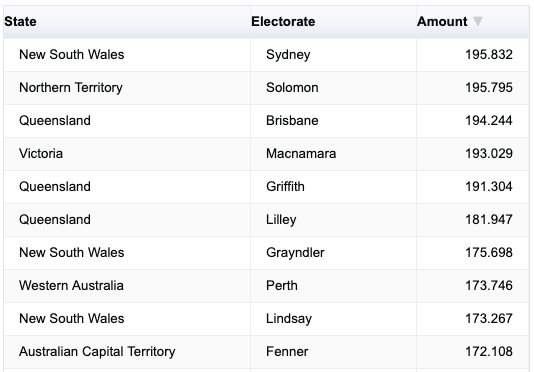The regions getting the most out of budget...and the least

Australians living in metropolitan Sydney are set to gain the most from the Federal Budget, should the Coalition win the next election.
Those living in Adelaide’s outer-north, Lyons in Tasmania and Hinkler in Queensland will receive the least.
Analysis from the National Centre for Social and Economic Modelling, based at the University of Canberra, has warned Treasurer Josh Frydenberg’s 2019/20 Federal Budget will widen the gap between the rich and the poor.
Related story: Who are the winners and losers out of the 2019 budget
Related story: What the budget means for you
Related story: $100 million on roads and transport – what each state gets
“The budget’s effect on the poverty rate – the proportion of households living on less than 50 per cent of median income – is to reduce it by 0.2 percentage points by 2024-25. This is a fairly small reduction,” researchers Robert Tanton, Hai Anh La and Jinjing Li said in a piece for The Conversation.
“But due to the tax cuts in 2024-25 raising the net incomes for high-income households, this means income inequality will be higher.”
The Coalition has pledged to entirely remove the 37 per cent tax bracket and lower the 32.5 per cent bracket, meaning all Australians earning between $45,001 to $200,000 will pay a personal income tax rate of 30 per cent.
And, they argued, that’s why wealthier suburbs will also gain the most.
The most:
The analysis pointed to the Wentworth, North Sydney, Warringah, Sydney and Grayndler as the electorates set to reap the most benefits from the 2019/20 policy, compared to the 2019 policy.
These are the 10 electorates set to gain the most, as measured by the change in annual disposable income per capita.

The least:At the other end of the spectrum, Adelaide’s Spence, Hinkler in Queensland, Lyons in Tasmania and Page and Lyne in NSW are set to benefit the least.
These are the 10 electorates set to gain the least, as measured by the change in annual disposable income per capita.

Why?
“When it comes to the impact by Commonwealth Electoral Division, we can see that by 2024-25 urban areas gain the most, and regional areas the least.
“This is because households in urban areas tend to have higher incomes, and the tax cuts in 2024-25 mean electoral divisions with higher income households will benefit the most.”
NATSEM also found middle-high income couples with children are set to score more than single Australians, while men and older Australians are also likely to have more put back in their pockets.
But unemployed Australians and pensioners will benefit the least.
“This is because changes to the tax and welfare system most benefit those paying tax. Those who don’t earn enough income to pay tax benefit least,” they explained.
“The message from this analysis is that the changes to the tax and welfare system in this budget benefits those with higher incomes and who are paying tax, with little to no gains in future years to some of those low income earners who aren’t paying tax.”
Make your money work with Yahoo Finance’s daily newsletter. Sign up here and stay on top of the latest money, news and tech news.

 Yahoo Finance
Yahoo Finance 
